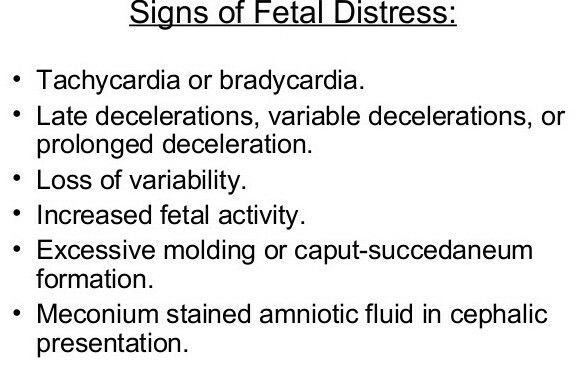Recognizing the Signs of Fetal Distress: A Parent’s Guide
Welcome aboard the journey of parenthood! While this adventure is filled with excitement and joy, it’s also brimming with the responsibility of ensuring the well-being of your little one even before they arrive in the world. One crucial aspect is understanding and recognizing the signs of fetal distress. Let’s explore what you should look out for, together!
What is Fetal Distress?
Fetal distress refers to the complications that may prevent your baby from getting enough oxygen during pregnancy or labor. It’s a term that captures various conditions signaling that your baby may not be doing as well as they should. Recognizing these signs can help you seek timely medical attention and intervention.
Key Signs of Fetal Distress to Watch Out For
As expectant parents, understanding the language your baby speaks through signals and movements is crucial. Here are some signs that could indicate fetal distress:
- Decreased Movement: If you notice a significant decrease in your baby’s usual activity level or movement patterns, it may be time to consult your healthcare provider.
- Abnormal Fetal Heart Rate: An unusually fast or slow fetal heart rate detected during prenatal visits can be a sign of distress. During labor, continuous monitoring can catch such irregularities.
- Meconium in the Amniotic Fluid: If meconium (the baby’s first stool) is found in the amniotic fluid, it could indicate that the baby experienced stress and passed stool while still inside.
- Excessive Cramping and Back Pain: While discomfort is common during pregnancy, excessive uterine cramping or severe back pain can sometimes signal complications.
Monitoring and Testing for Fetal Distress
In order to get a clearer picture of your baby’s health, your doctor may recommend several tests and monitoring techniques. These include:
- Non-Stress Test (NST): This test measures your baby’s heart rate as they move and establishes a baseline of wellness.
- Biophysical Profile (BPP): Combining an ultrasound evaluation with an NST, this test provides a more comprehensive view of your baby’s health.
- Contraction Stress Test (CST): Used less frequently, this test monitors the baby’s heart rate in response to contractions to assess how they will handle the stress of labor.
These monitoring tools help to ensure that any signs of distress are not overlooked. Regular prenatal appointments are vital for this reason.

Recognizing the Signs of Fetal Distress: A Parent’s Guide
Welcome aboard the journey of parenthood! While this adventure is filled with excitement and joy, it’s also brimming with the responsibility of ensuring the well-being of your little one even before they arrive in the world. One crucial aspect is understanding and recognizing the signs of fetal distress. Let’s explore what you should look out for, together!
What is Fetal Distress?
Fetal distress refers to the complications that may prevent your baby from getting enough oxygen during pregnancy or labor. It’s a term that captures various conditions signaling that your baby may not be doing as well as they should. Recognizing these signs can help you seek timely medical attention and intervention.
5 Things Parents Should Know in Preparing for Signs of Fetal Distress
- Know Your Baby’s Patterns: Familiarize yourself with your baby’s normal movement patterns so that you can detect any potential changes, which might indicate distress.
- Understand Risk Factors: Be aware of the potential risk factors that could lead to fetal distress, such as maternal health conditions, pregnancy complications, or lifestyle choices.
- Stay Informed on Prenatal Testing: Educate yourself about prenatal testing that can help monitor your baby’s health and recognize signs of fetal distress early.
- Practice Good Prenatal Care: Regular prenatal appointments are crucial for monitoring the health of both mother and baby, including signs of fetal distress.
- Have a Birth Plan: Consult with your healthcare provider to have a plan in place for labor and delivery, addressing any potential issues that may arise, including how to deal with fetal distress.
Key Signs of Fetal Distress to Watch Out For
As expectant parents, understanding the language your baby speaks through signals and movements is crucial. Here are some signs that could indicate fetal distress:
- Decreased Movement: If you notice a significant decrease in your baby’s usual activity level or movement patterns, it may be time to consult your healthcare provider.
- Abnormal Fetal Heart Rate: An unusually fast or slow fetal heart rate detected during prenatal visits can be a sign of distress. During labor, continuous monitoring can catch such irregularities.
- Meconium in the Amniotic Fluid: If meconium (the baby’s first stool) is found in the amniotic fluid, it could indicate that the baby experienced stress and passed stool while still inside.
- Excessive Cramping and Back Pain: While discomfort is common during pregnancy, excessive uterine cramping or severe back pain can sometimes signal complications.
Monitoring and Testing for Fetal Distress
In order to get a clearer picture of your baby’s health, your doctor may recommend several tests and monitoring techniques. These include:
- Non-Stress Test (NST): This test measures your baby’s heart rate as they move and establishes a baseline of wellness.
- Biophysical Profile (BPP): Combining an ultrasound evaluation with an NST, this test provides a more comprehensive view of your baby’s health.
- Contraction Stress Test (CST): Used less frequently, this test monitors the baby’s heart rate in response to contractions to assess how they will handle the stress of labor.
These monitoring tools help to ensure that any signs of distress are not overlooked. Regular prenatal appointments are vital for this reason.
See more great Things to Do with Kids in New Zealand here. For more information see here
Disclaimer
The articles available via our website provide general information only and we strongly urge readers to exercise caution and conduct their own thorough research and fact-checking. The information presented should not be taken as absolute truth, and, to the maximum extent permitted by law, we will not be held liable for any inaccuracies or errors in the content. It is essential for individuals to independently verify and validate the information before making any decisions or taking any actions based on the articles.




